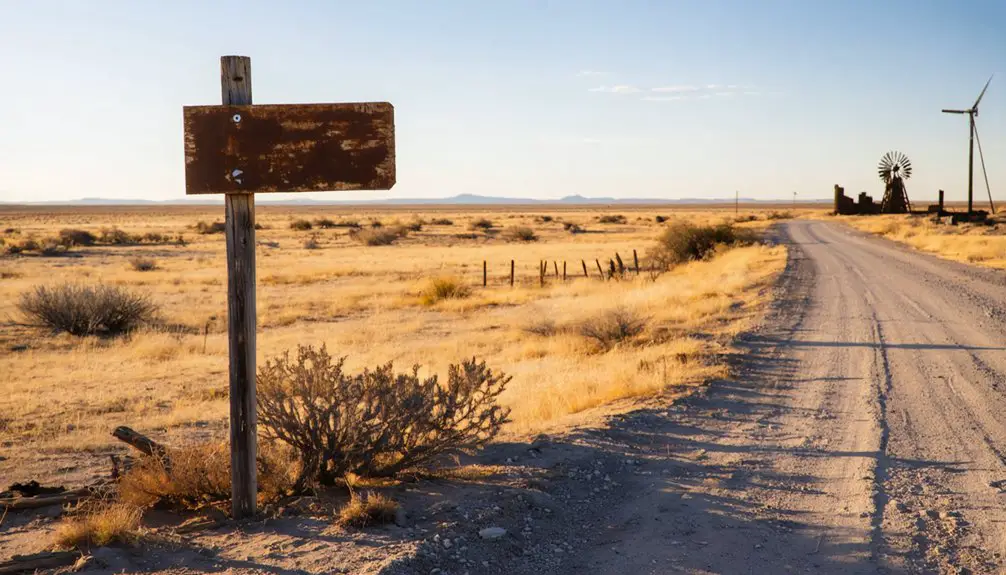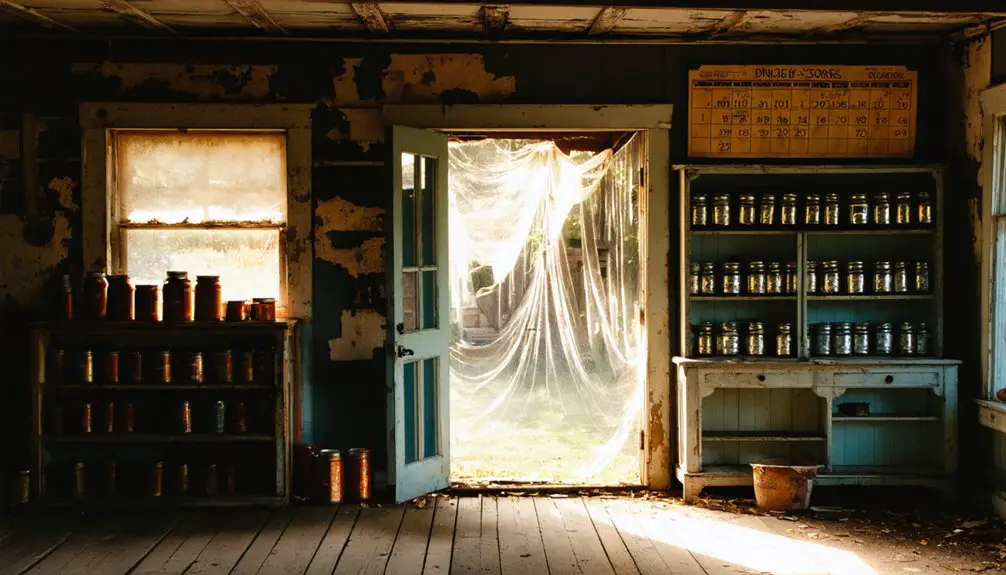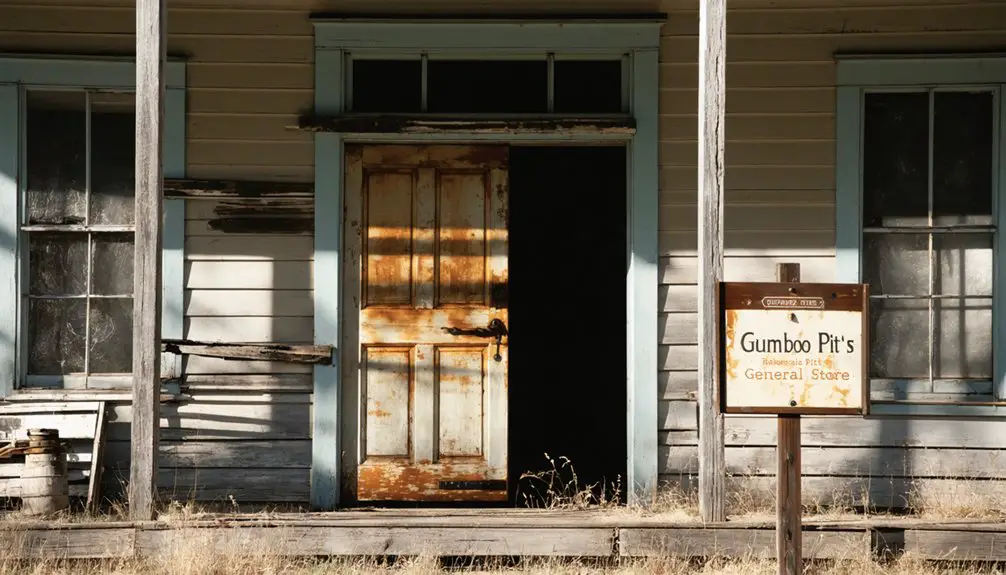You’ll find Gumbo Pit, a vanished railroad stop from the 1890s, about 3 miles northwest of downtown Oklahoma City. Named for its sticky clay soil, this modest trading post served as a connection point between Native American merchants and settlers along the Union Pacific Railroad. While the town never grew beyond its railway roots, you can still spot traces of its existence through old railroad grades and industrial relics that hint at its brief but intriguing past.
Key Takeaways
- Gumbo Pit was a railroad stop established by Union Pacific in the 1890s, named after the sticky clay soil in the area.
- The settlement appeared on railroad maps from 1892 to 1920s but never developed into a proper town due to infrastructure limitations.
- Located 3 miles northwest of downtown Oklahoma City, the site served as a trading hub for Native American merchants and settlers.
- The area’s economy briefly thrived on oil extraction and railroad commerce before declining in the early 20th century.
- Today, only remnants of railroad grades and ties remain, with the area now absorbed by Oklahoma City’s industrial parks and housing.
The Origins Behind the Name
While many Oklahoma ghost towns earned their names from economic booms or cultural touchstones, Gumbo Pit‘s peculiar moniker stems from the region’s distinctive soil composition.
You’ll find its name significance rooted in the heavy, sticky clay soil known as “gumbo” that characterized parts of Oklahoma’s landscape.
When Union Pacific Railroad established this stop in the 1890s, they likely drew inspiration from the geographic characteristics of the area, though curiously, historical records don’t indicate particularly muddy conditions at the site.
The term “pit” suggests a natural depression where soil or water might’ve collected. Operating from 1892 to 1925, the stop played a vital role in regional railroad transportation.
Unlike the state’s typical boom-town narratives, Gumbo Pit’s naming reflects a practical, observation-based approach that railroad workers often used when designating stops along their routes.
Similar to two thousand other ghost towns across Oklahoma, Gumbo Pit eventually succumbed to changing economic conditions and population shifts.
Early Settlement and Development
You’ll find Gumbo Pit’s early settlement rooted in Oklahoma’s railroad expansion of the 1890s, when Union Pacific established a strategic spur junction near present-day Oklahoma City.
The site’s primary function remained focused on railroad operations rather than commercial or residential growth, serving as a minor logistical point where trains could connect northbound towards Warr Acres. Today, industrial parks have completely transformed the landscape. Like many other settlements that failed to secure railroad routing, Gumbo Pit’s location proved disadvantageous for long-term development.
While the location appeared on railroad maps between 1892 and the 1920s, it never developed beyond its role as a railroad stop, lacking the essential infrastructure and population needed to transform into a proper town.
Soil and Settlement Origins
As the Union Pacific Railroad expanded through Oklahoma in the late 19th century, the settlement of Gumbo Pit emerged around 1892 at a modest rail stop, taking its name from the distinctive clay-heavy soil that would shape its destiny.
You’ll find that the soil’s impact on this small community was profound – the dense, sticky gumbo clay created significant settlement challenges for early residents who struggled with poor drainage and unstable ground for building foundations.
While the railroad brought the promise of connectivity, the harsh realities of the soil limited agricultural success and permanent development. The town’s history mirrored that of promising coal towns like Kusa, which also faced eventual abandonment.
You can trace how settlers adapted by carefully choosing building sites with better drainage, but ultimately, the environmental constraints proved too challenging for sustained growth, and Gumbo Pit remained a minor transportation hub until its decline in the 1920s.
Early Trading Activities
During its early settlement years, Gumbo Pit emerged as a modest trading hub where Native American merchants and frontier settlers converged along the Union Pacific line.
You’d have found Cherokee and Creek traders offering traditional pottery, moccasins, and jewelry alongside settlers’ agricultural goods and basic supplies. Many traders displayed over 100,000 items representing various tribal crafts and traditions. The railroad stop, though small, played a crucial role in connecting local commerce to broader markets.
The trading traditions that took root here reflected the rich cultural exchange between indigenous peoples and settlers.
You would’ve witnessed bartering, direct sales, and the loading of goods onto rail cars. While the settlement never grew into a major commercial center, its trading activities sustained the surrounding blackland prairie communities until the eventual decline of the railroad stop.
Transportation Hub Development
While natural terrain features initially dictated travel routes through Gumbo Pit, the settlement’s transportation network evolved from primitive trails into a complex hub serving the Oklahoma Territory. You’d have found early settlers maneuvering unpaved “gumbo roads” on horseback and in wagons, adapting their routes with each season’s challenges.
The arrival of the railroad transformed Gumbo Pit’s settlement patterns dramatically. Railway depots, positioned every ten miles, attracted commercial interests and land claims, though you’d have witnessed quite a scramble during the Land Run of 1889. Similar to the diverse geology of the Edwards Plateau region, the area’s varied terrain created natural transportation corridors that influenced settlement patterns. The German Mennonite farmers established several settlements along key transportation routes, contributing to the area’s agricultural development.
The town’s position near rail lines proved essential for connecting rural areas to regional markets, despite the rocky limestone terrain and dense hardwood forests that complicated infrastructure development. Early facilities along transportation routes started as simple supply cabins before growing into more established structures with modern amenities.
Life in the Early Days
Life in Gumbo Pit centered around its Union Pacific Railroad stop, where transient workers and their families carved out a modest existence between the 1890s and 1920s. You’d have found no permanent buildings or established neighborhoods here – just the comings and goings of railroad crews maintaining the crucial connection between Warr Acres and points beyond.
The transient lifestyle meant you wouldn’t have seen schools, stores, or churches in Gumbo Pit itself. Instead, you’d have relied on nearby Oklahoma City for your basic needs and social interactions.
Railroad workers lived in basic, temporary housing, their daily routines dictated by the rhythm of arriving and departing trains. Despite its name, the terrain wasn’t particularly muddy, making the daily work of maintaining the rail line manageable.
Geographic Features and Location

If you’d visited Gumbo Pit in its heyday, you’d have found it perched along a distinctive railroad grade that descended from the north before curving eastward through what’s now Oklahoma City’s industrial district.
The ghost town’s location, about 200 yards east of NW 5th Street and Ann Arbor Street in Oklahoma County, places it squarely within the modern metropolitan area’s manufacturing zone.
The terrain, while not particularly muddy despite its name, features scattered trees and remnants of the old Union Pacific rail line that once connected this junction point to the region’s main east-west railway. Similar to how the Tongue River Canyon cuts through varied landscapes in Wyoming and Montana, the local topography shows evidence of historic transportation routes.
Like many abandoned settlements in Oklahoma, Gumbo Pit stands as a testament to the state’s rich historical heritage.
Terrain and Soil Composition
Although Gumbo Pit‘s name might suggest marshy terrain, this former Oklahoma railroad stop actually sits on a gently descending hillside roughly 200 yards east of NW 5th Street and Ann Arbor Street in Oklahoma City.
You’ll find the old railroad grade curving eastward as it descends, following the natural contours of the land to meet a main east-west line.
Despite its name, you won’t encounter the muddy, clay-rich “gumbo” soil conditions here.
Instead, the soil stability has proven sufficient to support both industrial development and mature trees that now line the abandoned grade.
The vegetation changes over time have transformed what was once prairie into a wooded urban fringe environment, with mixed hardwoods adapting well to Oklahoma City’s continental climate of hot summers and cold winters.
Regional Landmarks and Borders
While modern Oklahoma City has engulfed the former site of Gumbo Pit, you’ll find this ghost town’s location precisely marked by the intersection of historic rail lines roughly 200 yards east of NW 5th Street and Ann Arbor Street.
Today’s industrial parks and manufacturers dominate the landscape where this Union Pacific Railroad stop once thrived, showcasing the dramatic urban development that’s transformed the area.
The site’s historical significance remains visible in the old railroad grades, particularly where the northern spur descends a hill before curving eastward to meet the main line.
This grade extends two miles northward through what’s now residential neighborhoods and past an elementary school, silently testifying to the transportation network that once defined this vanished community’s borders with neighboring Warr Acres.
Distance From Major Cities
The strategic position of Gumbo Pit places it squarely within Oklahoma City’s urban fabric, just under 3 miles northwest of downtown OKC proper.
You’ll find this historic site about 105 miles southwest of Tulsa, Oklahoma’s second-largest city, connected by the I-44 corridor that marks generations of urban developments along the state’s central axis.
If you’re heading south from Edmond, you’ll travel roughly 15 miles along I-35 to reach the former railway stop.
Norman lies 20 miles to the south, while Midwest City sits 10-12 miles east.
These historical connections remain visible through the surrounding industrial parks and manufacturing facilities that have replaced the original town site, though the ghost town’s legacy endures in the heart of OKC’s metropolitan sprawl.
Economic Activities and Commerce

During its heyday, Gumbo Pit’s economy thrived primarily through oil extraction and railroad commerce, establishing itself as a quintessential Oklahoma boomtown in the early 20th century.
In early 1900s Oklahoma, Gumbo Pit emerged as a classic boomtown, built on the twin foundations of oil wells and railroad ties.
You’d have found independent contractors working oil leases before company laborers took over, while the railroad stop facilitated the transportation of crude oil and other goods to distant markets.
The town’s economic foundation rested on three pillars: the oil boom that attracted workers and equipment suppliers, the railroad impact that connected the town to larger commercial networks, and the agricultural activities in surrounding areas.
Despite agricultural challenges faced by cotton farmers and the cyclical nature of mining influences, Gumbo Pit achieved notable commercial diversification.
As economic shifts occurred, the town adapted by providing essential services to both permanent residents and transient workers.
The Path to Abandonment
Despite its early economic promise, Gumbo Pit’s path toward abandonment began in earnest as railroad activity dwindled through the 1920s.
You’d have witnessed dramatic population shifts as residents sought better opportunities in larger towns, leaving behind a settlement that had never fully developed beyond its railroad stop origins.
The town’s economic isolation deepened when newer transportation routes bypassed it completely.
Without schools, post offices, or other essential institutions to anchor the community, you wouldn’t have found much reason to stay.
The Great Depression dealt the final blow, accelerating the exodus of younger generations to urban areas.
Remaining Traces and Structures

Searching for Gumbo Pit’s physical remains today, you’ll find little more than a visible railroad grade descending east of NW 5th Street and Ann Arbor Street in Oklahoma City.
You can trace remnants of old railroad ties and partial tracks along the former route, with the northbound spur to Warr Acres still detectable for about two miles through modern developments.
Trees have reclaimed the land where the town once stood, marking its general boundaries but concealing any remaining structures beneath their cover.
The ghost town has been absorbed by the expanding metro area, with industrial parks and mid-century housing subdivisions now occupying these historic grounds.
These urban relics – the railroad grade and scattered hardware – are all that’s left to remind you of Gumbo Pit’s brief existence.
Local Legends and Stories
While Gumbo Pit’s physical remains have largely vanished, the town’s unusual name and mysterious past have sparked countless local legends.
You’ll hear tales of ghostly sightings along the old Union Pacific railroad tracks, where workers once reported strange occurrences during their night shifts. The town’s sudden disappearance from maps after 1925 has fueled stories of phantom trains and spectral passengers still waiting at the abandoned station.
Like many Oklahoma ghost towns, Gumbo Pit’s folklore tales have become intertwined with broader regional myths.
Local storytellers weave accounts of unexplained lights, mysterious creatures, and vanishing travelers into the fabric of this former railroad stop’s history.
Though no concrete evidence supports these supernatural claims, the site’s eerie quietness continues to captivate ghost hunters and history buffs alike.
Preservation Efforts and Historical Significance

Once a minor stop along the Union Pacific railroad, Gumbo Pit stands as a tribute to Oklahoma’s dynamic railroad era from 1892 to the early 1920s.
Unlike larger ghost towns that’ve attracted major preservation efforts, you’ll find Gumbo Pit’s legacy preserved mainly through grassroots historical documentation and passionate community involvement.
While you won’t discover extensive ruins or restored buildings here, local history enthusiasts keep Gumbo Pit’s memory alive through video explorations, mapping projects, and storytelling.
It’s one of Oklahoma’s 2,000 ghost towns, but its preservation story differs from famous sites like Picher or Slick.
Instead of formal historic designations or archaeological surveys, you’ll find Gumbo Pit’s history maintained through the dedication of local residents who refuse to let this piece of railroad heritage fade into obscurity.
Frequently Asked Questions
Are There Any Surviving Photographs of Gumbo Pit From Its Active Years?
You won’t find any surviving photographs of Gumbo Pit from its active period, as historical archives and databases don’t contain documented images of this small railroad stop from the late 1800s to 1920s.
Did Any Famous Outlaws or Notable Historical Figures Visit Gumbo Pit?
While millions of outlaws roamed Oklahoma Territory, you won’t find any historical records of outlaw encounters or historical legends at this modest railroad stop – no famous figures ever visited here.
What Native American Tribes Originally Inhabited the Area Before Gumbo Pit?
You’ll find rich cultural significance in the Osage, Wichita, and Caddo peoples who first called this land home, their tribal heritage echoing through time before European settlers arrived.
Were There Any Major Accidents or Disasters That Occurred in Gumbo Pit?
You won’t find any documented Gumbo Pit accidents or disasters in historical records, which isn’t surprising since it was just a brief railroad stop that faded away by the mid-1920s.
Does Anyone Still Own Property or Hold Land Titles in Gumbo Pit?
You won’t find any direct property ownership or land titles for Gumbo Pit today – it’s all been absorbed into Oklahoma City’s jurisdiction, with modern industrial parks and residential developments claiming the area.
References
- https://en.wikipedia.org/wiki/List_of_ghost_towns_in_Oklahoma
- https://www.okhistory.org/publications/enc/entry?entry=GH002
- https://allthatsinteresting.com/ghost-towns/9
- https://kids.kiddle.co/List_of_ghost_towns_in_Oklahoma
- https://www.youtube.com/watch?v=v0wmzvkhtZY
- https://okmag.com/blog/a-ghostly-site/
- https://www.ghosttowns.com/states/ok/gumbopit.html
- https://ktul.com/news/local/oklahomas-secret-past-ghost-towns-of-oklahoma-11-20-2015
- https://www.journee-mondiale.com/en/unveiling-oklahomas-hidden-gems-3-cherokee-trading-posts-that-redefine-cultural-tourism/
- https://apps.dtic.mil/sti/tr/pdf/ADA103441.pdf



